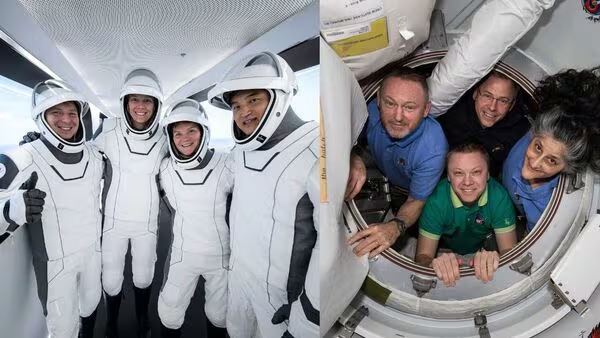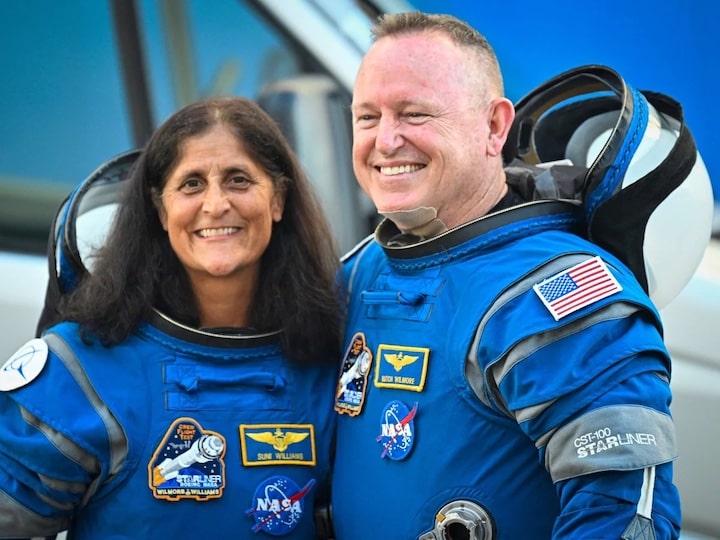NASA has officially confirmed that Sunita Williams return, along with three other crew members, will take place on March 18, 2025. Their anticipated splashdown is set to take place off the coast of Florida, marking the end of a prolonged mission aboard the International Space Station (ISS). Sunita Williams return will be aboard a SpaceX Crew Dragon spacecraft, accompanied by fellow astronaut Butch Wilmore, another American astronaut, and a Russian cosmonaut.
Sunita Williams’ Extended Stay in Space
Originally, Sunita Williams return was not supposed to be delayed for this long. She and Butch Wilmore traveled to the ISS in June 2024 aboard Boeing’s Starliner spacecraft. However, their return was delayed due to technical malfunctions, including propulsion issues and helium leaks in the Starliner. NASA decided that Crew Dragon, which successfully arrived at the ISS on March 17, would bring them back safely to Earth.
The delay prolonged Williams’ mission from the originally planned eight days to over nine months. While this exceeds the standard six-month ISS rotation for astronauts, it is still shorter than NASA astronaut Frank Rubio’s record-breaking 371-day stay and the world record of 437 days set by Russian cosmonaut Valeri Polyakov aboard the Mir space station. Despite the challenges, Williams continued her duties on the ISS, contributing to research and maintenance activities.
The Return Journey

NASA confirmed that Sunita Williams return and her team’s return process will begin on March 18. The space agency scheduled the Crew Dragon’s hatch closure preparations for March 17 at 10:45 p.m. EDT (March 18, 8:15 a.m. IST). Following that, the spacecraft will undock from the ISS and embark on its journey back to Earth. The descent and splashdown are expected at approximately 5:57 p.m. EDT (March 19, 3:27 a.m. IST).
NASA chose to move the return date up by a day due to favorable weather conditions. The timing ensures a smooth landing and simplifies the recovery process. Live coverage of the return will be available on NASA’s official channels, allowing people across the world to witness this historic event.
The Role of Crew Dragon in Sunita Williams’ Return

SpaceX’s Crew Dragon spacecraft has played a crucial role in Sunita Williams return to Earth safely. It has proven to be a reliable alternative to Boeing’s Starliner, which faced repeated technical setbacks. Crew Dragon, designed for human spaceflight, has already completed several missions to and from the ISS under NASA’s Commercial Crew Program.
The spacecraft provides astronauts with a secure environment during re-entry and splashdown. It is equipped with advanced heat shields to protect the crew from extreme temperatures as they re-enter Earth’s atmosphere. After a controlled descent, Crew Dragon deploys parachutes to slow down before landing in the ocean. NASA and SpaceX recovery teams will be ready to retrieve the crew once they safely splash down.
Sunita Williams’ Contributions to Space Exploration
Throughout her career, Sunita Williams has played an essential role in space exploration. She has spent significant time aboard the ISS, conducting various scientific experiments, spacewalks, and maintenance operations. Her latest mission adds to her legacy as one of NASA’s most experienced astronauts.
During her extended stay, Williams continued to work on crucial research projects. She assisted in scientific experiments related to microgravity’s effects on human health, technology development, and space agriculture. Her efforts contribute to the future of long-duration missions, including NASA’s Artemis program, which aims to return humans to the Moon and eventually reach Mars.
Challenges Faced During the Extended Mission
Sunita Williams return mission highlights the unpredictable nature of space travel. Technical issues with the Starliner spacecraft forced her to remain on the ISS much longer than expected. However, she and her fellow crew members adapted to the situation, demonstrating the resilience and expertise required for space missions.
Living in space for an extended period presents physical and psychological challenges. Astronauts experience muscle loss, bone density reduction, and exposure to increased radiation levels. Additionally, the mental strain of isolation and prolonged separation from family can be taxing. Despite these difficulties, Williams remained dedicated to her mission and continued to inspire future generations of space explorers.
What’s Next for Sunita Williams?
Once Sunita Williams return to Earth is complete, she will undergo medical evaluations and debriefings at NASA’s facilities. These assessments will help scientists understand the effects of extended space missions on the human body. Afterward, she will participate in public engagements, sharing her experiences with students, scientists, and space enthusiasts worldwide.
Sunita Williams return to Earth will also provide valuable insights for upcoming space missions. NASA and its partners will analyze the challenges faced during her prolonged stay to improve spacecraft reliability and mission planning. Her experience underscores the importance of having backup options for astronaut transportation, a crucial factor as space agencies prepare for longer missions beyond Earth’s orbit.
Conclusion
Sunita Williams return to Earth marks the end of an unexpected yet historic mission. Despite challenges, she and her crew continued their vital work on the ISS, contributing to groundbreaking research and technological advancements. With the SpaceX Crew Dragon ensuring a safe journey back, the world eagerly awaits Sunita Williams return and homecoming. NASA’s decision to prioritize safety and adaptability reinforces the importance of precision and innovation in human space exploration.
As Sunita Williams return approaches, her journey serves as a testament to the resilience of astronauts and the advancements in space travel technology. Her return will not only bring valuable scientific insights but also inspire a new generation of explorers to reach for the stars.



